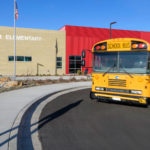ASLA Awards: Contributing to “Impact Growth” in Idaho
This year’s awards theme for the American Society of Landscape Architects (ASLA) Idaho/Montana chapter was “Impact Growth.” Given the need to responsibly and thoughtfully develop green spaces in our rapidly growing urban areas, this was a timely topic at the chapter’s biennial conference. Speakers discussed urban development, wetlands, national parks, and landscape architecture’s role in helping to shape both urban and rural areas.
Angela Hansen, a landscape architect who grew up in Idaho and has been with CTA/Cushing Terrell for 13 years, was on hand to accept two ASLA awards for projects she led that demonstrated responsible, impactful design principles.

Angela Hansen, far right, joins fellow landscape architects as they celebrate the projects recognized as part of the ASLA ID MT awards.
Thompson Lake House Garden: Honor Award | Residential Design
An example of adaptive reuse, our CTA team was responsible for Lot 2 of an 80-acre site in Eagle, Idaho. Formerly a cattle ranch that was then converted into a gravel mine, the area’s natural environment had been severely damaged, and landscape architects were brought in to help rehabilitate the site into an oasis for both people and wildlife.
The work on the overall site included restoring an existing stream with native vegetation, pools, and gravel bars for feeder fish and spawning beds. Natural water flow was allowed back into mining pits to form lakes, and islands were created and planted with vegetation to attract water fowl. Green space development consisted of native trees and shrubs, meandering streams, and open areas. To make the site suitable for residential and recreational use, engineered soil and stone-terraced walls were used to raise four large lots out of the flood zone.
Of those lots, Lot 2 was envisioned as a serene, yet open and welcoming residence that blends interior and exterior spaces. To accomplish this, CTA’s architects and landscape architects worked closely together to ensure a seamless transition between the two environments.
Projects demonstrated:
1) The quality of the landscape architect’s contribution to the project
2) Environmental responsibility
3) Opportunities for the project to have a significant impact on the environment
4) The level of skill/proficiency
5) Use of new technologies, methodologies, or approaches
Large windows and operable hangar doors extend interior spaces to the outside, with views focused on the surrounding natural features. Footbridges cross a stream and lead to a boardwalk with a waterfall pool at one end and a viewing platform above the lake at the other. The back patio is terraced above a lakeside beach, and the terraces are filled with drought-tolerant vegetation, shrubs, and trees. The hardscape, vehicular and pedestrian, is comprised of dry-set concrete pavers that allow rain and stormwater to pass through into the ground.

For the Thompson Lake House on Lot 2, the team worked to seamlessly blend the interior spaces of the residence with the exterior garden spaces, which include an array of environments: a meandering stream, cascading waterfall, and lakeside, terraced patio filled with native plants.

Operable hangar doors allow the exterior of the home to flow out to the landscaped patio area, which is terraced down to the lakeside beach.
Shoreline District Urban Framework Plan: Merit Award | Planning and Analysis
Approximately 195 acres in size and adjacent to the Boise Central Business District, the Shoreline District is not only a mix of suburban and urban development, but also connects to some of Boise, Idaho’s prized recreational spaces: the Boise River, Greenbelt, and Ann Morrison Park.
With great potential for a re-invigoration of the area, CTA’s landscape architecture and urban planning team worked with Capital City Development Corporation and the City of Boise to conduct an analysis focused on environmental, infrastructure, and economic data, coupled with extensive stakeholder engagement and public outreach to create a development and investment strategy for the district.
The team developed conceptual plans for four subareas of the Shoreline District — the Boise River Greenbelt, Lusk, Island Festival Street, and Shoreline Park — with projects that would incorporate green infrastructure, storm water management, activated multi-use corridors, and enhanced urban gathering and recreation spaces. For the Boise River Greenbelt, for example, the plan considered culturally and environmentally sensitive areas of the river, and through context-sensitive design, created a balance between wildlife habitat and places for people.
Multiple strategies were integrated into each area with a focus on green infrastructure, enhanced mobility, and special projects to activate streets and plazas for pedestrian use. The overall plan provides a path to creating a district that celebrates and enhances natural spaces, while generating economic opportunities and creating welcoming neighborhood areas.
Visit the CCDC Shoreline District Urban Renewal site for the full Framework Plan.
Projects demonstrated:
1) The quality of the landscape architect’s contribution to the project
2) Functionalism
3) Relationship to context
4) Environmental responsibility
5) Opportunities for the project to have a significant impact on the environment
6) Overall relevance to landscape architecture, the public, and built environment
7) Ability to increase the public’s awareness of landscape architecture
8) Level of skill/proficiency

Within each subarea of the Shoreline District, the team designed projects that incorporate green infrastructure, storm-water management, activated multi-use corridors, and enhanced urban gathering spaces for public use.
 A detailed conceptual rendering shows the flow from residential and commercial buildings out to the Greenbelt (with separate lanes for pedestrians and bikes), which then transitions to the Boise River habitat.
A detailed conceptual rendering shows the flow from residential and commercial buildings out to the Greenbelt (with separate lanes for pedestrians and bikes), which then transitions to the Boise River habitat.


